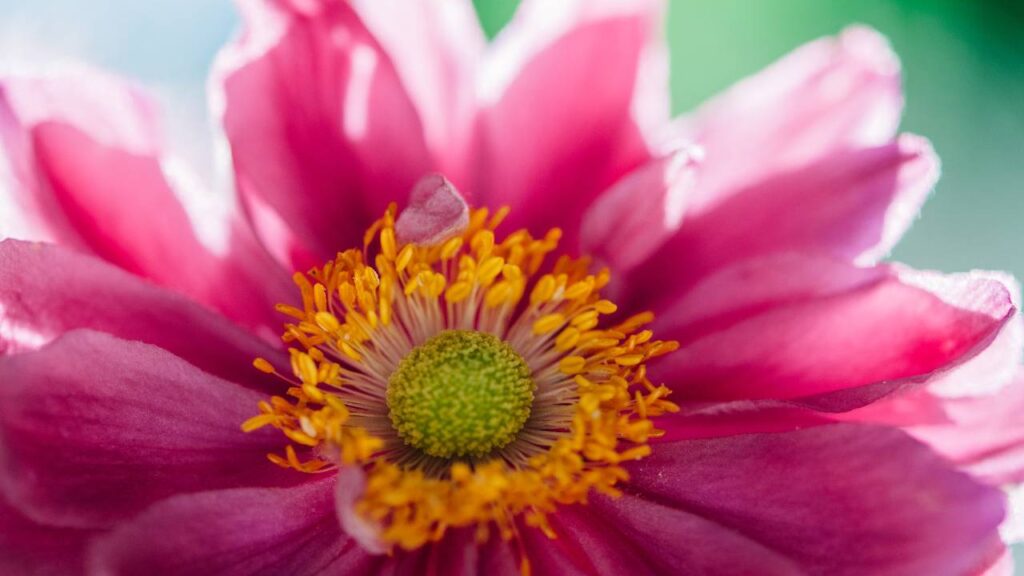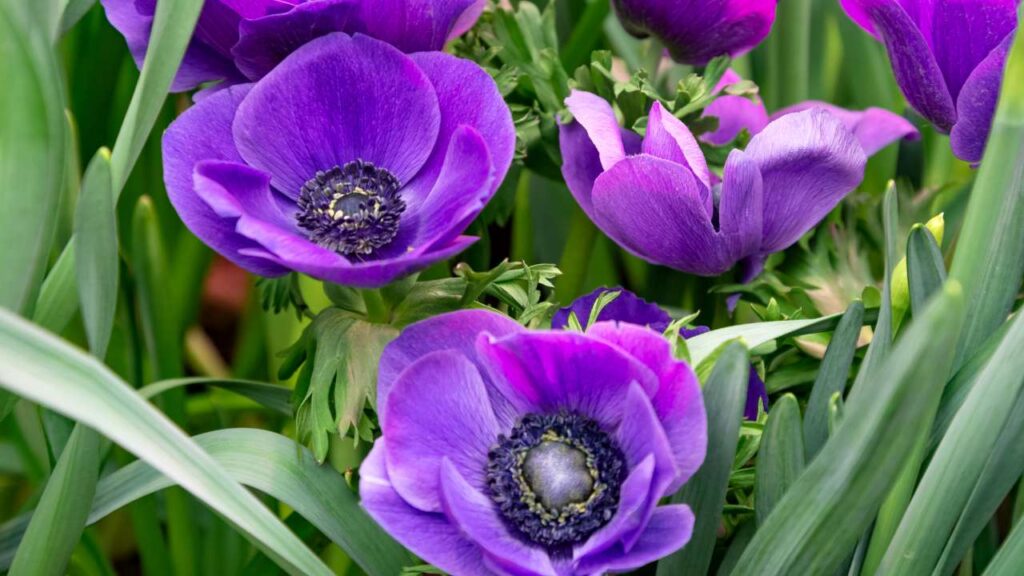Anemones are known as windflowers. they are a captivating and diverse group of flowers that have fascinated people for centuries. With their delicate petals, vibrant colors, and deep symbolism, anemones have found their way into my hearts and gardens. In this comprehensive article, I will embark on an extensive exploration of the history of this beautiful flower, uncover the meanings associated with each color variation, dive into their spiritual significance, discuss cultivation techniques, discover where to find anemones in their natural habitats, explore their medicinal properties and uses, examine drying techniques, and provide essential care guidelines for these enchanting flowers.
History of Anemone
Anemones are members of the Ranunculaceae family and are widely distributed across the globe, encompassing various regions such as Europe, Asia, and North America. Their natural habitats are diverse and can be found in a range of ecosystems, from lush woodlands and meadows to rocky slopes and alpine regions.

In Europe.
Anemones are abundant and can be found in countries such as the United Kingdom, France, Germany, Greece, and Italy. They flourish in woodlands and meadows, adorning the landscape with their vibrant blooms. In the United Kingdom, species like Anemone nemorosa, commonly known as wood anemone, thrive in ancient woodlands, creating breathtaking carpets of white or pale pink flowers in spring.
In Asia.
Boasts a rich diversity of anemones, with countries like Japan, China, and Turkey being home to various species. In Japan, the enchanting Japanese anemone can be found gracing gardens and natural areas. China is known for its diverse array of anemones, including the Poppy anemone, celebrated for its striking red, white, and blue flowers.
In North America
The flower can be found in a wide range of habitats, from the eastern woodlands of the United States to the alpine regions of Canada. In the Pacific Northwest region of the United States, species like Anemone occidentalis and Anemone multifida thrive in moist woodlands and mountainous areas, adding a touch of beauty to the natural landscape.

The global distribution of anemones highlights their adaptability to various climatic conditions and their ability to thrive in different ecosystems. Whether in the enchanting woodlands of Europe, the serene gardens of Asia, or the diverse landscapes of North America, anemones continue to captivate and inspire with their remarkable beauty.
“The majestic anemones possess a rich historical legacy. intertwining with various cultures and time periods. In this section, I will dive into the origins of anemones, their cultural significance, and notable references in mythology, art, and literature.”

1. Origin and Geographic Distribution:
Anemones belong to the Ranunculaceae family and are native to regions across the globe. Their natural habitats range from woodlands and meadows to rocky slopes and alpine regions.
2. Cultural Significance and Symbolism:
Anemones hold cultural significance in numerous societies, often symbolizing love, fragility, anticipation, and transformation. In ancient Greek and Roman cultures, anemones were associated with deities such as Aphrodite and Flora, while in Asian traditions, they held various symbolic meanings, including luck, protection, and longing.
3. Mythological and Literary References:
Anemones are mentioned in several mythological and literary works. Greek mythology tells tales of Aphrodite and Adonis, attributing the origin of anemones to the goddess’ tears. In literature, anemones are frequently used as metaphors for fleeting beauty, delicate nature, or the transience of life.
Symbolic Meaning of Anemone Colors
Each color variation of an anemone holds its own unique symbolism. Understanding the meanings behind these colors allows for intentional use in floral arrangements and symbolic gestures. Here are the meanings associated with different anemone colors.
Red Anemones

Red anemones symbolize passionate love, desire, and intense emotions. They convey deep affection and can be used to express feelings of romantic love.
Pink Anemones

Pink anemones represent gentleness, grace, admiration, and joy. They are often given as gestures of appreciation or to celebrate new beginnings.
White Anemones

White anemones symbolize purity, innocence, spirituality, and new beginnings. They are commonly used in weddings, signifying the pure bond of love and the start of a new chapter.
Purple Anemones

Purple anemones embody dignity, pride, luxury, and power. They are associated with admiration and make an elegant addition to floral displays.
Blue Anemones

Blue anemones are rare and highly sought after for their unique color. They represent tranquility, peace, and inner harmony. Blue anemones can create a calming atmosphere in any setting.
Spiritual Meaning of Anemone
Anemones possess spiritual significance and are believed to embody certain qualities and energies. Here are some common spiritual meanings associated with anemones.
1. Transformation and Renewal
Anemones symbolize transformation, reminding us of the cyclical nature of life and the importance of adapting and growing.
2. Protection and Warding off Evil
Anemones are believed to possess protective qualities, warding off negative energies and evil spirits. They may be used in rituals or placed in homes for protective purposes.
3. Emotional Healing
Anemones are associated with emotional healing and the ability to overcome grief or loss. They offer solace, comfort, and a reminder that beauty can emerge from challenging times.
4. Awakening and Intuition
Anemones are thought to enhance intuition and facilitate a connection to higher consciousness. They encourage us to trust our instincts and embrace our inner wisdom.
Cultivation of Anemone Flowers
Growing anemones can be a rewarding experience, whether in gardens or containers. In this section. we will explore the cultivation requirements, including planting, soil conditions, watering, propagation methods, and care guidelines.

1. Choosing Anemone Varieties
Select anemone varieties suitable for your climate and growing conditions. Popular species include Poppy anemone, Balkan anemone, and Japanese anemone, each with its specific characteristics.
2. Planting Time and Location
Anemone bulbs should be planted in early spring or fall, depending on the variety. Choose a location with well-draining soil and sufficient sunlight based on the specific requirements of the selected species.
3. Soil Preparation
Prepare the soil by loosening it and removing any weeds or debris. Anemones prefer well-draining soil enriched with organic matter. Ensure the pH level is neutral to slightly acidic.
4. Planting Depth and Spacing
Plant anemone bulbs at a depth of 2 to 3 inches (5 to 8 cm) and space them 4 to 6 inches (10 to 15 cm) apart. Follow the recommended spacing for the specific variety to allow for optimal growth.
5. Watering and Moisture
Provide regular watering to keep the soil evenly moist. Avoid overwatering, as excessive moisture can cause bulb rot. Mulching can help retain moisture and suppress weed growth.
6. Fertilization
Apply a balanced, water-soluble fertilizer during the growing season. Follow the instructions on the fertilizer package for proper dosage and timing.
7. Propagation
Anemones can be propagated through division or by collecting and planting seeds. The division is the most common method, usually done during the dormant season.
8. Pruning and Deadheading
Regularly remove spent flowers and any dead or yellowing foliage to promote new growth and maintain the plant’s appearance. Prune anemones in late fall or early spring to remove diseased or damaged parts and to shape the plant as needed.
9. Pest and Disease Control
Monitor for common pests, such as aphids, slugs, and snails, which may feed on anemone foliage. Use appropriate organic or chemical methods to control pests if necessary (prefer organic). ensure proper air circulation and moisture control to prevent fungal diseases.
Natural Habitat and Where to Find Anemone Flowers
In addition to cultivation, anemone flowers can be found in their natural habitats. The following are some locations where anemones can be seen in their wild beauty.

Europe: Anemones are abundant in various European countries, including the woodlands and meadows of the United Kingdom, the alpine regions of Switzerland, and the Mediterranean regions of Greece and Italy.
Asia: In Asia, anemones can be found in countries such as Japan, China, and Turkey. They thrive in woodlands, mountainous areas, and regions with temperate climates.
North America: Anemone species are widespread throughout North America. They can be found in diverse ecosystems, including forests, meadows, and prairies. Some popular locations include the Pacific Northwest of the United States and parts of Canada.
Medicinal Uses of Anemone
This flower has been utilized for its medicinal properties for centuries. While it is important to consult a healthcare professional before using any plant medicinally, anemones have been associated with various therapeutic uses. Here are some notable medicinal properties and applications of anemone flowers.

1. Anti-Inflammatory and Analgesic Effects
Certain anemone species, such as Anemone pulsatilla and Japanese anemone, contain compounds that possess anti-inflammatory and analgesic properties. These properties make them potentially useful for relieving pain and reducing inflammation in conditions such as arthritis, joint pain, and headaches.
2. Respiratory Health
Anemone flowers have traditionally been used to support respiratory health. They are believed to possess expectorant properties, helping to alleviate coughs, bronchitis, and other respiratory conditions. Preparations made from anemone flowers can be consumed as herbal teas or used in steam inhalations.
3. Skin Conditions
Anemone extracts have been used topically to address various skin conditions, including eczema, rashes, and minor wounds. The anti-inflammatory properties of anemone flowers may help reduce skin inflammation and promote healing. However, caution should be exercised, and it is advisable to consult a healthcare professional before using anemone flowers for topical applications.
4. Menstrual Disorders
Anemone flowers have been used traditionally to address menstrual irregularities, alleviate menstrual cramps, and reduce discomfort associated with menstruation. However, it is important to seek professional advice before using anemone flowers for such purposes.
Drying Techniques for Anemone Flowers

Air Drying
Air drying is a simple and effective method for drying anemone flowers. Cut the flowers when they are fully bloomed but before they start to wither. Gather small bunches of flowers and tie their stems together with a string or rubber band. Hang the bunches upside down in a well-ventilated, dark, and dry location. Allow the flowers to dry naturally for several weeks until they are completely dried, and their petals feel papery to the touch.
Silica Gel Drying
Silica gel is a desiccant commonly used for drying flowers. Fill a container with silica gel and bury the anemone flowers in it, making sure the flowers are completely covered. Gently pour more silica gel around and on top of the flowers, ensuring they are well-encased. Close the container tightly and leave it undisturbed for several weeks. The silica gel will absorb moisture from the flowers, gradually drying them while maintaining their shape and color.
Pressing
Pressing is a technique that allows for flat, preserved anemone flowers. Place the flowers between sheets of absorbent paper or parchment paper, and make sure they do not overlap. Press the flowers between heavy books or using a flower press. Leave them pressed for a few weeks, periodically checking for dryness. Once the flowers are completely dried, carefully remove them from the paper, and store them in a dry area.
Care and Maintenance of Anemone Flowers
To maintain the health, beauty, and longevity of anemone flowers. it is important to provide them with proper care and maintenance. Here are some essential guidelines.

Watering
Anemones prefer consistently moist but well-draining soil. Water them regularly, particularly during dry periods, to keep the soil evenly moist. Avoid overwatering, as excessive moisture can cause bulb rot.
Sunlight and Temperature
Anemones thrive in locations with partial shade to full sun, depending on the species. They prefer cooler temperatures, ranging from 50°F to 70°F (10°C to 21°C). Provide protection from intense heat and strong winds, which can damage delicate petals.
Soil Conditions
Anemones prefer well-draining soil rich in organic matter. Prepare the soil by incorporating compost or well-rotted manure before planting. This helps improve soil fertility and drainage.
Mulching and Weed Control
Apply a layer of organic mulch around the plants to retain moisture, suppress weed growth, and maintain a stable soil temperature. Be cautious not to mulch too close to the base of the plant, as it may cause excess moisture retention and promote rot.
Fertilization
Anemones benefit from regular fertilization during the growing season. Use a balanced, water-soluble fertilizer specifically formulated for flowering plants. Follow the instructions on the fertilizer package for proper dosage and frequency.
Pruning and Deadheading
Regularly remove spent flowers and any dead or yellowing foliage to promote new growth and maintain the plant’s appearance. Prune anemones in late fall or early spring to remove diseased or damaged parts and to shape the plant as needed.
Pest and Disease Control
Monitor for common pests, such as aphids, slugs, and snails, which may feed on anemone foliage. Use appropriate organic or chemical methods to control pests if necessary. Additionally, ensure proper air circulation and moisture control to prevent fungal diseases.
Anemones, with their mesmerizing history, profound symbolism, and delicate beauty, hold a special place in the realm of flowers. Either grown in gardens, encountered in the wild, used for medicinal purposes, or preserved through drying techniques. anemones continue to enchant and inspire. By understanding their nature and how to care for them. you can cultivate and appreciate the exquisite beauty of anemone flowers while honoring their rich heritage background.












